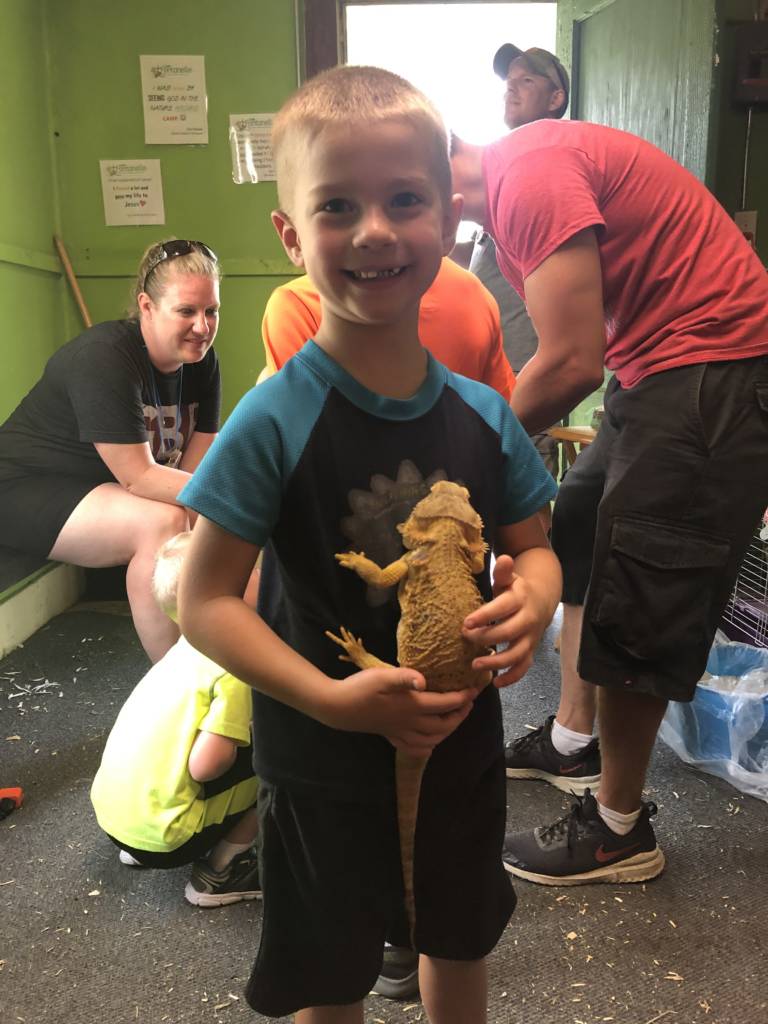
The Barn
Bees are found on every continent on earth, anywhere you can find flowering plants. They range from tiny Perdita minima in the American southwest to the Wallace’s giant bee or raja ofu in Indonesia. But of course there’s more to camp than just bees! We have our own petting barn at Camp Fontanelle, with awesome creatures like llamas, lizards, rabbits, and more! Check out some of these resources from the Omaha Henry Doorly Zoo about more of God’s creation across the world!
Activities hosted by the Henry Doorly Zoo; images and info from Wikipedia.
Splendid tree frog
Splendid tree frogs
The magnificent tree frog (Ranoidea splendida), also known as the splendid tree frog, is a tree frog species first described in 1977. It has a limited range, only occurring on the north-western coast of Australia in the Northern Territory and Western Australia. It has a similar appearance to, and can be confused with, the closely related White’s tree frog. [https://en.wikipedia.org/wiki/Magnificent_tree_frog]
Springhaas
Springhaas
The South African springhare (Pedetes capensis) (Afrikaans: springhaas) is a large and unusual rodent. Despite the name, it is not a hare. It is one of two extant species in the genus Pedetes, and is native to southern Africa.
[https://en.wikipedia.org/wiki/South_African_springhare]
Three banded armadillo
three-banded armadillo
The southern three-banded armadillo (Tolypeutes matacus), also known as La Plata three-banded armadillo or Azara’s domed armadillo, is an armadillo species from South America. It is found in parts of southwestern Brazil, northern Argentina, Paraguay and Bolivia, at elevations from sea level to 770 m (2,530 ft).
[https://en.wikipedia.org/wiki/Southern_three-banded_armadillo]
Crested Coua
CRESTED COUA
The crested coua (Coua cristata) is a medium-sized, approximately 44 cm long, greenish-grey coua with grey crest, blue bare orbital skin, rufous breast, brown iris, black bill and legs, white belly and long white-tipped purplish-blue tail feathers. The crested coua is distributed and endemic to forests, savanna and brushland of Madagascar. It is found from sea level to altitude of 900 metres.
[https://en.wikipedia.org/wiki/Crested_coua]
Lemur
Lemur
Lemurs (from Latin lemures – ghosts or spirits) are mammals of the order Primates, divided into 8 families and consisting of 15 genera and around 100 existing species. They are native only to the island of Madagascar. Most existing lemurs are small, have a pointed snout, large eyes, and a long tail. They chiefly live in trees (arboreal), and are active at night (nocturnal). [https://en.wikipedia.org/wiki/Lemur]
Photo by Arjan Haverkamp – originally posted to Flickr as 2007-07-15-12h53m31.IMG_1008e, CC BY 2.0, https://commons.wikimedia.org/w/index.php?curid=9617158
Black and Rufous Elephant Shrew
Black and Rufous Elephant Shrew
The black and rufous elephant shrew, (Rhynchocyon petersi) the black and rufous sengi, or the Zanj elephant shrew is one of the 17 species of elephant shrew found only in Africa. It is native to the lowland montane and dense forests of Kenya and Tanzania. Like other members of the genus Rhynchocyon, it is a relatively large species, with adults averaging about 28 cm (11 in) in length and 450-700 g (1.0-1.5 lb) in weight. [https://en.wikipedia.org/wiki/Black_and_rufous_elephant_shrew]
Pink-backed pelican
Pink-backed pelican
The pink-backed pelican (Pelecanus rufescens) is a bird of the pelican family. It is a resident breeder in the swamps and shallow lakes of Africa, southern Arabia, and southern India; it has also apparently extirpated in Madagascar.
[https://en.wikipedia.org/wiki/Pink-backed_pelican]
Lesser Kudu
LESSER KUDU
The lesser kudu (Tragelaphus imberbis) is a forest antelope found in East Africa. It is placed in the genus Tragelaphus and family Bovidae. It was first scientifically described by the English zoologist Edward Blyth in 1869. The head-and-body length is typically 110–140 cm (43–55 in). Males reach about 95–105 cm (37–41 in) at the shoulder, while females reach 90–100 cm (35–39 in). Males typically weigh 92–108 kg (203–238 lb) and females 56–70 kg (123–154 lb). The females and juveniles have a reddish-brown coat, while the males become yellowish grey or darker after the age of 2 years. Horns are present only on males. The spiral horns are 50–70 cm (20–28 in) long, and have two to two-and-a-half twists.
[https://en.wikipedia.org/wiki/Lesser_kudu]
Freshwater Crocodile
Freshwater crocodile
The freshwater crocodile (Crocodylus johnstoni or Crocodylus johnsoni; see below), also known as the Australian freshwater crocodile, Johnstone’s crocodile or also known as freshie, is a species of crocodile endemic to the northern regions of Australia. Unlike their much larger Australian relative, the saltwater crocodile, freshwater crocodiles are not known as man-eaters, although they will bite in self-defence, and brief non-fatal attacks have occurred, apparently the result of mistaken identity.
[https://en.wikipedia.org/wiki/Freshwater_crocodile]
Nicobar Pigeon
Nicobar pigeon
The Nicobar pigeon (Caloenas nicobarica) is found on small islands and in coastal regions from the Andaman and Nicobar Islands, India, east through the Malay Archipelago, to the Solomons and Palau. It is the only living member of the genus Caloenas, and may be the closest living relative of the extinct dodo, as well as the extinct Rodrigues solitaire. [https://en.wikipedia.org/wiki/Nicobar_pigeon]